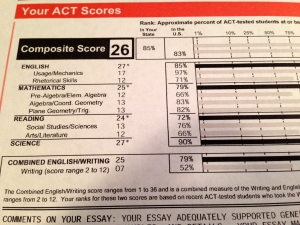 As explained in my March 11 blog post, the College Board will introduce a redesigned SAT in 2016. This month, ACT announced that it, too, will be making changes, though they are not nearly as extreme as those being made to the SAT.
As explained in my March 11 blog post, the College Board will introduce a redesigned SAT in 2016. This month, ACT announced that it, too, will be making changes, though they are not nearly as extreme as those being made to the SAT.
The new SAT will incorporate changes to both the test’s content and the way it’s scored. In contrast, with the ACT, changes to the test itself will be minimal. They will include an increase from three to four probability and statistics questions on the math section and the addition of reading section questions that will require students to examine two passages. (Currently, reading section questions only refer to one passage.) The optional writing section will include additional information to help students respond to the essay prompt.
The bulk of the changes to the ACT, which will be phased in beginning in 2015, will involve the way scores are reported. Currently, ACT score reports include: scores on each of four sections of the test (English, math, reading, and science); a composite score that is the average of the section scores; and, if students take the optional writing section, a writing score and a combined English/Writing score.
According to Inside Higher Ed, the new ACT score reports also will include:
- “A STEM score based on students’ scores on the math and science sections.
- An English language score based on students’ scores on English, reading and writing.
- A ‘progress toward career readiness’ score that will be based on students’ demonstrated knowledge in areas that could set them up for success in the work place.
- A ‘text complexity progress indicator’ that will be based on all of the writing passages (not just in the reading section).
- New scores on the optional writing test . . . so they will receive separate additional scores on ideas and analysis, development and support, organization, and language use.”
In announcing these changes, spokespersons for the ACT explained that the additional scores will give students a better understanding of their strengths and weaknesses, and students can use that information to study for and improve their scores on subsequent ACT’s. Additionally, the added scores will help students ascertain how prepared they are for college and the workforce.
In May, ACT announced that it will begin offering its test online in 2015. Initially, the ACT will continue to be offered in its current paper format, but eventually the test only will be available in a digital format.
It will be interesting to see if the changes to the SAT and ACT will affect the number of students who take each test. Historically, more students have taken the SAT, but for the first time last year, more students took the ACT.





